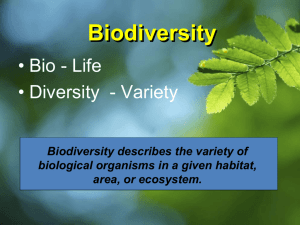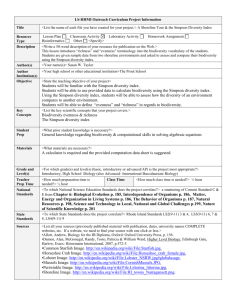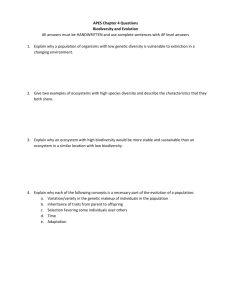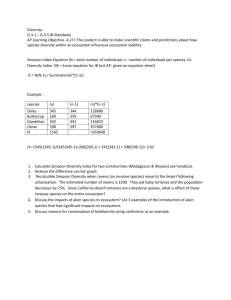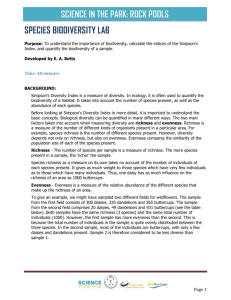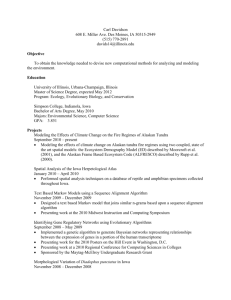In ecology, a diversity index is a statistic which is intended to
advertisement
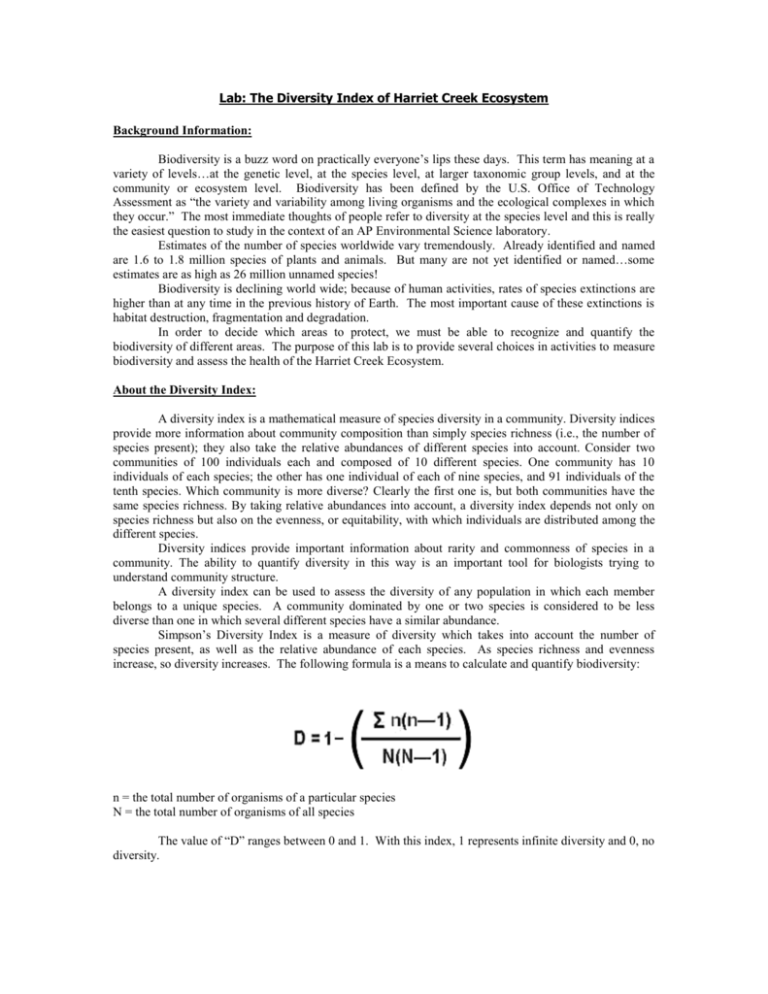
Lab: The Diversity Index of Harriet Creek Ecosystem Background Information: Biodiversity is a buzz word on practically everyone’s lips these days. This term has meaning at a variety of levels…at the genetic level, at the species level, at larger taxonomic group levels, and at the community or ecosystem level. Biodiversity has been defined by the U.S. Office of Technology Assessment as “the variety and variability among living organisms and the ecological complexes in which they occur.” The most immediate thoughts of people refer to diversity at the species level and this is really the easiest question to study in the context of an AP Environmental Science laboratory. Estimates of the number of species worldwide vary tremendously. Already identified and named are 1.6 to 1.8 million species of plants and animals. But many are not yet identified or named…some estimates are as high as 26 million unnamed species! Biodiversity is declining world wide; because of human activities, rates of species extinctions are higher than at any time in the previous history of Earth. The most important cause of these extinctions is habitat destruction, fragmentation and degradation. In order to decide which areas to protect, we must be able to recognize and quantify the biodiversity of different areas. The purpose of this lab is to provide several choices in activities to measure biodiversity and assess the health of the Harriet Creek Ecosystem. About the Diversity Index: A diversity index is a mathematical measure of species diversity in a community. Diversity indices provide more information about community composition than simply species richness (i.e., the number of species present); they also take the relative abundances of different species into account. Consider two communities of 100 individuals each and composed of 10 different species. One community has 10 individuals of each species; the other has one individual of each of nine species, and 91 individuals of the tenth species. Which community is more diverse? Clearly the first one is, but both communities have the same species richness. By taking relative abundances into account, a diversity index depends not only on species richness but also on the evenness, or equitability, with which individuals are distributed among the different species. Diversity indices provide important information about rarity and commonness of species in a community. The ability to quantify diversity in this way is an important tool for biologists trying to understand community structure. A diversity index can be used to assess the diversity of any population in which each member belongs to a unique species. A community dominated by one or two species is considered to be less diverse than one in which several different species have a similar abundance. Simpson’s Diversity Index is a measure of diversity which takes into account the number of species present, as well as the relative abundance of each species. As species richness and evenness increase, so diversity increases. The following formula is a means to calculate and quantify biodiversity: n = the total number of organisms of a particular species N = the total number of organisms of all species The value of “D” ranges between 0 and 1. With this index, 1 represents infinite diversity and 0, no diversity. As an example, let us work out the value of D for a single sample of ground vegetation in the beach area. Of course, sampling one area would not give you a reliable estimate of the diversity of the beach flora. Several samples would have to be taken and the data pooled to give a better estimate of overall diversity. Please note that there is no necessity to be able to identify all of the species, provided they can be distinguished from each other. In the example data table below, please notice that the species have been identified. This is not necessary, as long as you can identify and quantify each species by its physical characteristics. You could define and name the species yourself, such as “species A”, “species B”, and “species C”. Please remember that, when you are trying to identify Protistans in the Harriet Creek samples! Species Number (n) n(n-1) Sea holly 2 2 Sand couch 8 56 Sea bindweed 1 0 Sporobolus pungens 1 0 Echinophora spinosa 3 6 Total 15 64 N = 15 n(n-1) = 64 Putting the figures into the formula for Simpson's Index: Simpson's Index of Diversity = 0.7 With an Index of 0.7, the ecosystem is fairly diverse. The closer the value is to 1, the more diverse the ecosystem, the healthier the ecosystem! Procedure: Your task is going to be to collect a sample of water at the Harriet Creek. You will then begin to classify and count all of the organisms you find in your samples in order to calculate the diversity index, using “Simpson’s Method”. Begin by building yourself a data table similar to the one above, but with unlimited rows (accounting for unlimited number of species…in other words, leave the bottom off of it!). This will be for your personal, as well as your group’s data. You will eventually need another table for the classroom set, but that can be inserted at a later date. In your data table, you may also want to build a column for qualitative data, as I’ll be looking for that when I grade this lab as well. In qualitative data, you can describe movement, color, consumption observed…etc. You will be photographing each organism you classify with a digital camera. I will have a few to offer you, or you may provide your own. You may try doing this with your cell phone, but that is challenging. These photos should be put in your quadrille in a section labeled “key”. This will be a significant section for this lab, depending upon the print size of your photos…so don’t make them too large! In other words, in the section you label “Key”, you will have photographic documentation of each species of organism included in your count, so if your data table has listed “Organism A” as one of the species you’re counting, in your key, you will indicate “Organism A” looks like this: (insert photo here) This “identifying and counting” task will take multiple days. You may use my classroom key, or the internet to help you classify or name your organisms, but remember, that is less important than actually getting a correct number of each species. Each day, share your data with everyone in your lab group, so that each of you has the same data in your table. Please keep in mind that while your data tables don’t have to be identical, but the data does! When we exhaust our supply of water, or after four days, (whichever comes first) we will be compiling the classroom set of data on the board in a giant data table. You will calculate the Simpson’s Diversity Index twice. One calculation will be done with your group’s data, and one with the entire classroom’s data. In this way, you will see the value of larger samples in accuracy of calculations. Analysis Questions: Diversity Index Lab 1. Calculate the Simpson’s Diversity Index of the Harriet Creek for both your group’s data, and the classroom data. Show all work. Describe the index as either healthy, or unhealthy. Justify. Were the results of each calculation different? Why, or why not? Which were most accurate? Why? 2. List the single most abundant species in your classroom data table, and write a plausible explanation as to why this was the most abundant species. 3. List the single scarcest species in your classroom data table, and write a plausible explanation as to why this was the scarcest. 4. If you conducted your count and diversity index calculations for the following areas, describe how the values might differ from what you found. 5. Death Valley, Ca. El Yunque Rainforest, Puerto Rico The East African Savanna Why is knowledge of how to calculate and apply the Simpson Diversity Index beneficial for someone to know? (besides the fact that you need to know it for the AP test!)

